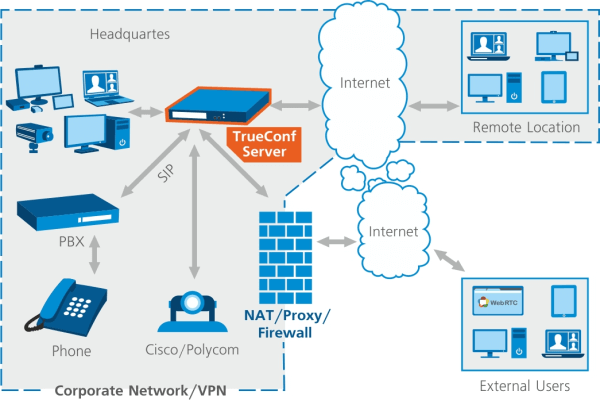 By Michael Gotalsky,
By Michael Gotalsky,
TrueConf CEO
Adopting WebRTC in an enterprise video conferencing setting.
Enterprise video conferencing is a hard nut to crack. You can call it a very traditional market. Interviewing someone from this “old” guard of RTC is something I’d love to do. This is why when the opportunity presented itself with TrueConf I couldn’t resist.
TrueConf is a vendor you won’t necessarily hear about – it isn’t Avaya, Cisco or Polycom, but it has a strong footprint within Europe. It also has WebRTC (and VP8) as part of is offering.
Here is an interview I had with Michael Gotalsky, CEO of TrueConf.
What is TrueConf all about?
We develop solutions to organize an SVC-based and MCU-less secure corporate unified communications system with the support of FullHD video conferencing on all popular desktop and mobile platforms on personal devices, workstations, meeting rooms and conference halls in the shortest time possible.
The whole idea behind TrueConf is that all modern UC/VC features already included within our software calledTrueConf Server. Namely: multi-point video conferencing, recordings, NAT/Firewall traversal, access to VoIP, built-in gateway to join SIP/WebRTC/RTSP devices and endpoints, etc.
Moreover, our product works on any regular PC under dedicated or virtualized MS Windows 2008/2010/2012 server, which makes it available for practically everyone.
Those are probably the most major distinguishing features of our solutions.
You already have a unified communications deployment. Why add WebRTC?
- Customers have needs that can be best fulfilled using WebRTC, namely to:
- Simplify the ability to broadcast corporate video conferences on a large number of participants. As the size of a single conference in our system is limited to 120 participants in the TCP mode and 250 in UDP Multicast mode. In case of WebRTC, the number of “observers” is limited by the server’s channel bandwidth only.
- Simplify the enabling of external users to the corporate video conferencing system, as well as eliminating the need to create additional accounts on the server.
- Give partners the ability to create any integration aimed video conferencing projects based on our infrastructure using HTML5, for example video ATMs.

At what touch points have you decided to place WebRTC and why?
We have once developed a NPAPI/ActiveX web client for Windows, which was sold to partners in order to integrate video conferencing into their websites and intranet systems. Therefore, we always had the need for the web version.
Now with the advent of WebRTC, it is possible to make such an application cross-platform and more user-friendly. Moreover, it meets the new customer needs, described in the previous question.
What signaling have you decided to integrate on top of WebRTC?
We are using our own signaling even in our own server (besides that, we have SIP, WebRTC and RTSP interoperability). The reason is that we are using more features which are missing or are not well standardized in SIP, like multiple video streams in a single conference (we are not mixing streams on the server).
So we just implemented our own authorization/connection functions, which may be equivalent to signaling in Telco sense.
Backend. What technologies and architecture are you using there?
On backend we are using our own, all-in-one software solution for Windows Server 2003/2008/2012, fully developed within our company. It handles authorization, signaling (our proprietary TCP-based protocol, SIP, RTSP and recently added WebRTC), connects with corporate LDAP (Active Directory), and is able to record conferences, etc.
Group conferences are handled on backend using SVC. We are making our own SVC written over the VP8 codec. Currently in group conferences we are mixing all streams in one (unlike non-WebRTC clients), and all clients connect to server. SVC allows each client to receive stream of requested bitrate (thanks for RTCP bit rate feedback standardized in WebRTC, the thing missing in Flash for ages).
Where do you see WebRTC going in 2-5 years?
- We believe that in the coming year:
- WebRTC will not become a substitute for mobile applications because users have a very strong habit and trust for market based apps
- WebRTC simply will not gain popularity if Apple or Microsoft do not support it. From this perspective, we like Cisco’s initiative to add H.264 codec to the standard, and Vidyo’s idea to add SVC, although we have already made our own SVC for WebRTC
- There is some chance that in a few years WebRTC will replace desktop video conferencing solutions and specialized software. This will erase the line between web conferencing and plain software-based video conferencing
- WebRTC will not likely get the distribution in SmartTV, as from the experience of applications for smartphones, native apps are among the winners
- As for group video conferencing systems for meeting rooms, WebRTC will not replace such hardware even in 3 years
If you had one piece of advice for those thinking of adopting WebRTC, what would it be?
Do not waste time and effort on the invention of your own video conferencing server/bridge, license ours and focus on the application UX and GUI.
Given the opportunity, what would you change in WebRTC?
We are waiting for SVC client support, either VP9 written by Vidyo or at least the ability to code two streams from a single camera.
What’s next for TrueConf?
- To release WebRTC client with video/audio/content feedback
- To implement WebRTC client into our cloud solution called TrueConf Online
- To become the most widely adopted WebRTC corporate server
- Replacement of client applications for desktops with WebRTC browser-based ones is still under consideration, but not yet decided

